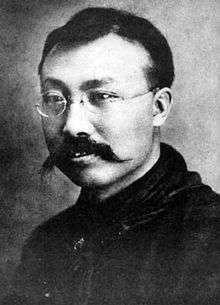Li Dazhao
| Li Dazhao | |
|---|---|
|
李大钊 李大釗 | |
 | |
| Personal details | |
| Born |
29 October 1888 Laoting, Tangshan, Qing Dynasty |
| Died |
28 April 1927 (aged 38) Peking, Republic of China |
| Nationality | Han Chinese |
| Political party | Communist Party of China |
| Alma mater | Waseda University |
| Li Dazhao | |||||||||
| Traditional Chinese | 李大釗 | ||||||||
|---|---|---|---|---|---|---|---|---|---|
| Simplified Chinese | 李大钊 | ||||||||
| |||||||||
| Courtesy name | |||||||||
| Chinese | 寿昌 | ||||||||
| |||||||||
Li Dazhao (simplified Chinese: 李大钊; traditional Chinese: 李大釗; October 29, 1888 – April 28, 1927) was a Chinese intellectual who co-founded the Communist Party of China with Chen Duxiu and other early communists in 1921.
Biography
Early life
Li was born in Laoting (a county of Tangshan), Hebei province to a peasant family. He started his formal modern education at Yongpingfu Middle school. From 1907 to 1913, he studied at Beiyang College of Politics and Law in Tianjin. From 1914 to 1916, Li studied political economy at Waseda University in Japan before returning to China in 1916. He did not finish his learning but was repelled by Waseda because of his long absences for his active participation into the anti-Yuan Shikai campaign in Shanghai in early 1916.
Librarian at Peking University
As a leading intellectual in the New Culture Movement, Li was recruited by Cai Yuanpei to head the library at Peking University. In this position he influenced a number of students in the May Fourth Movement, including Mao Zedong, who worked in the library's reading room.[1] Li was among the first of the Chinese intellectuals to look to China's villages as a basis for a political movement and was among the earliest to explore the Bolshevik government in the Soviet Union as a possible model for China's reform. Even as late as 1921, however, he still maintained warm relations with other New Culture figures such as Hu Shi.[2]
Co-founder of the CPC
By many accounts, Li was a nationalist and believed that the peasantry in China were to play an important role in China's revolution. As with many intellectuals of his time, the roots of Li's revolutionary thinking were actually mostly in Kropotkin's communist anarchism, but after the events of the May Fourth Movement and the failures of the anarchistic experiments of many intellectuals, like his compatriots, he turned more towards Marxism. Of course, the success of the Bolshevik Revolution was a major factor in the changing of his views. In later years, Li combined both his original nationalist and newly acquired Marxist views in order to contribute a strong political view to China (Meisner 1967, 178).
Li initiated the Peking Socialist Youth Corps in 1920 (Pringsheim 1962, p76), in advance of the first meeting of the Communist Party of China (CPC) in Shanghai in July, 1921. Though Li was unable to attend, he was named co-founder of the CPC, along with Chen Duxiu.
Under the leadership of Li and Chen, the CPC developed a close relationship with the Soviet controlled Comintern. At the direction of the Comintern, Li and Chen were inducted into the Kuomintang in 1922. Li was elected to the KMT's Central Executive Committee in 1924.
Death
Tensions between the Comintern, the KMT, and the CPC presented opportunities for political intrigue and opportunism. With the collapse of the United Front in 1927, Li was captured during a raid ordered by the Fengtian clique on the Soviet embassy in Peking (Beijing). Along with nineteen others arrested in the raid, he was executed by hanging on the orders of the warlord Zhang Zuolin on April 28, 1927.
Notes
- ↑ Murray, Stuart. The Library: An Illustrated History. New York, NY: Skyhorse Pub, 2009.
- ↑ Maurice J. Meisner, Li Ta-Chao and the Origins of Chinese Marxism (Cambridge: Harvard University Press, 1967).
References
| Wikimedia Commons has media related to Li Dazhao. |
- Original text based on marxists.org article, released under the GNU FDL.
- Meisner, Maurice (1967). Li Ta-Chao and the Origins of Chinese Marxism. Cambridge: Harvard University Press.
- Pringsheim, Klaus H. (Oct–Dec 1962). "The Functions of Chinese Communist Youth Leagues 1920–1949". The China Quarterly. 12: 75–91. doi:10.1017/s0305741000020762.